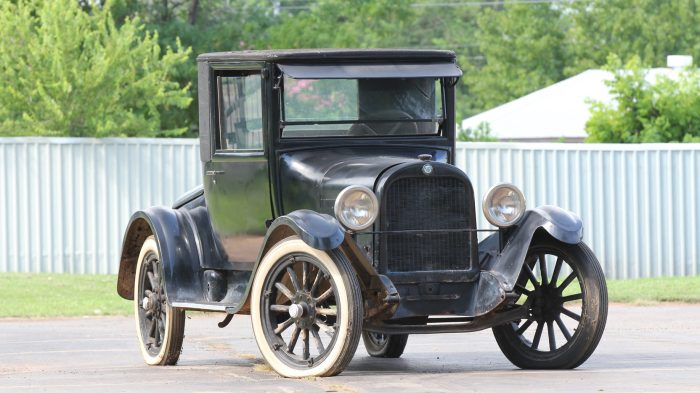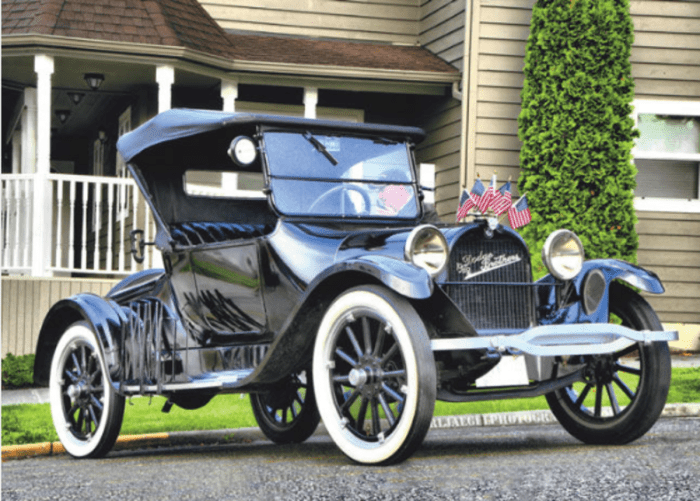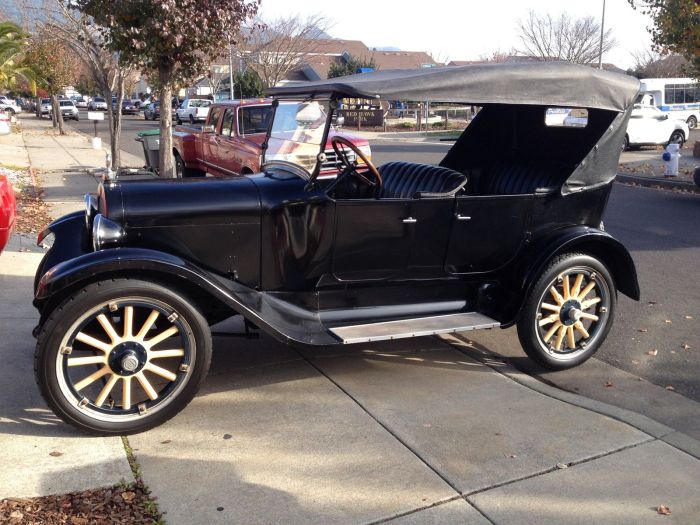1922 Dodge Antique represents a pivotal moment in American automotive history. This era witnessed the rise of the automobile as a symbol of progress and freedom, and the Dodge Brothers played a significant role in shaping this burgeoning industry. The 1922 Dodge model, with its distinctive design and innovative features, became a testament to the company’s commitment to quality and innovation.
This article delves into the fascinating world of the 1922 Dodge Antique, exploring its historical context, design, production, legacy, and restoration. We will examine the key features that made this model stand out from its contemporaries and discover the enduring impact it has had on automotive history.
Join us as we embark on a journey back in time to appreciate the craftsmanship and engineering brilliance that defined the 1922 Dodge Antique.
Historical Context

The 1920s marked a pivotal era in American automotive history, witnessing a surge in car production, widespread adoption, and the rise of iconic brands. This period was characterized by significant technological advancements, changing social norms, and a burgeoning middle class that embraced the automobile as a symbol of freedom and mobility.The Dodge Brothers, John and Horace Dodge, played a crucial role in the early development of the automobile industry.
Initially suppliers of parts for the Ford Motor Company, they established their own company in 1914, focusing on building sturdy and reliable vehicles. The Dodge Brothers’ success was built on their commitment to quality engineering and manufacturing practices, which quickly earned them a reputation for producing durable and dependable automobiles.
The 1922 Dodge Model Lineup and Key Features
The 1922 Dodge model lineup featured a range of vehicles designed to cater to diverse needs and preferences. Key features included:
- Dodge Brothers Touring Car:This was the flagship model, offering a spacious and comfortable ride for up to seven passengers. It featured a powerful four-cylinder engine, a durable chassis, and a stylish body design.
- Dodge Brothers Roadster:This two-seater model was popular among younger buyers and those seeking a more sporty driving experience. It featured a streamlined body design and a powerful engine, making it a capable and stylish vehicle.
- Dodge Brothers Coupe:This enclosed model offered a more luxurious and private ride, ideal for those seeking a comfortable and stylish vehicle for personal use. It featured a roomy interior, plush upholstery, and a powerful engine.
- Dodge Brothers Sedan:This four-door model was designed for families and those seeking a practical and spacious vehicle. It featured a roomy interior, comfortable seating, and a powerful engine.
Design and Features: 1922 Dodge Antique

The 1922 Dodge Brothers Model 118, commonly known as the Dodge Antique, embodied the design and engineering trends of its era, offering a blend of practicality and elegance. It was a car designed for both daily commuting and leisurely drives, reflecting the evolving needs of American society in the Roaring Twenties.
Exterior Design
The Dodge Antique’s exterior design showcased the distinct characteristics of the early 1920s. Its body, crafted from steel, was characterized by a boxy silhouette, a long hood, and a high beltline. The front featured a prominent radiator grille with vertical slats, while the rear sported a rounded trunk lid.
The vehicle’s exterior was available in a range of colors, including black, dark blue, and maroon, offering owners a choice to express their personal style. The use of chrome accents, such as the bumpers and door handles, added a touch of sophistication to the overall design.
The 1922 Dodge Antique, with its distinctive lines and timeless appeal, is a prime example of the enduring allure of classic cars. These vehicles, often admired for their craftsmanship and historical significance, are a testament to the evolution of automotive design.
classic cars enthusiasts often find themselves drawn to the 1922 Dodge Antique, recognizing its place in automotive history and its enduring appeal as a piece of Americana.
Mechanical Components
The Dodge Antique was powered by a four-cylinder, 3.2-liter engine, producing approximately 25 horsepower. This engine was coupled with a three-speed manual transmission, providing a smooth and reliable driving experience for the time. The vehicle’s chassis was constructed using a sturdy frame, offering a solid platform for its body and mechanical components.
It featured a front suspension with semi-elliptic leaf springs and a rear suspension with a live axle and semi-elliptic leaf springs.
Key Mechanical Specifications:
- Engine:4-cylinder, 3.2-liter, 25 horsepower
- Transmission:3-speed manual
- Brakes:Mechanical, rear wheel only
- Suspension:Front – semi-elliptic leaf springs, Rear – live axle with semi-elliptic leaf springs
- Wheelbase:115 inches
- Length:167 inches
- Width:59 inches
- Height:64 inches
- Weight:2,400 pounds
Interior Design
The interior of the Dodge Antique prioritized practicality and comfort. It featured a spacious cabin that could comfortably accommodate five passengers. The upholstery was typically made of cloth or leather, offering a comfortable seating experience. The dashboard was simple and functional, with essential gauges and controls.
A wooden steering wheel provided a classic touch, while the interior was often adorned with wood trim and accents.
Comfort Features:
- Spacious cabin:Designed to comfortably accommodate five passengers
- Upholstery:Available in cloth or leather options for a comfortable seating experience
- Wooden steering wheel:Added a classic touch to the interior
- Wood trim and accents:Enhanced the overall aesthetic of the cabin
Production and Sales

The 1922 Dodge Brothers Motor Car Company’s production and sales reflected the company’s commitment to manufacturing reliable and affordable automobiles for the growing American middle class. The company’s manufacturing techniques and sales figures provide valuable insights into the automotive industry of the early 1920s.
Manufacturing Techniques
Dodge Brothers employed advanced manufacturing techniques to produce its automobiles efficiently and affordably.
- Assembly Line Production:The company adopted the assembly line system, pioneered by Henry Ford, to streamline the production process. This method involved breaking down the car assembly into smaller, specialized tasks, allowing workers to focus on specific operations and improve efficiency.
- Mass Production:Dodge Brothers embraced mass production principles, utilizing standardized parts and interchangeable components. This allowed for faster and more consistent assembly, reducing production costs and making cars more affordable for a wider audience.
- Vertical Integration:The company implemented vertical integration, controlling various stages of production, from raw materials to finished vehicles. This strategy ensured quality control and reduced reliance on external suppliers.
Sales Figures and Market Reception
The 1922 Dodge enjoyed significant sales success, reflecting its popularity among American consumers.
- Production Numbers:Dodge Brothers produced a substantial number of vehicles in 1922, reflecting strong demand for their automobiles. The exact production figures are not readily available, but historical records indicate that Dodge produced tens of thousands of cars that year.
- Market Share:Dodge held a considerable market share in the American automotive industry during the early 1920s. The company’s focus on affordability and reliability made its cars attractive to a wide range of buyers, contributing to its market success.
Factors Contributing to Popularity, 1922 Dodge Antique
The 1922 Dodge’s popularity stemmed from several factors, including:
- Affordability:Dodge cars were known for their affordability, making them accessible to a broader segment of the population. This was particularly significant during a period when car ownership was still a luxury for many Americans.
- Reliability:Dodge vehicles were renowned for their durability and reliability, earning a reputation for being sturdy and dependable. This reputation contributed to the company’s strong sales figures and customer loyalty.
- Practicality:The 1922 Dodge was a practical car for everyday use, offering ample space for passengers and cargo. Its versatility appealed to families and individuals seeking a reliable and functional vehicle.
Legacy and Impact

The 1922 Dodge Antique, though not a groundbreaking model in terms of revolutionary technology, played a significant role in the evolution of the automobile industry. Its affordability and reliability contributed to the growing popularity of cars during the roaring twenties, while its design elements and engineering solutions influenced later Dodge models and the American automotive landscape.
Impact on Automotive Design and Technology
The 1922 Dodge Antique’s design, with its streamlined body and efficient engine, contributed to the evolution of automotive aesthetics and performance. Its four-cylinder engine, while not particularly powerful, offered a balance between fuel efficiency and adequate power for the time.
The car’s simple and robust construction ensured its reliability, making it a popular choice for both personal and commercial use. This emphasis on affordability and durability would become a hallmark of Dodge vehicles for decades to come.
The 1922 Dodge Antique, with its distinctive lines and classic design, represents a bygone era in automotive history. While its engine might not boast the horsepower of later models, it offers a glimpse into the early days of car manufacturing.
For a more modern take on Dodge’s legacy, consider the 1939 Dodge Sedan , which showcases a refined design and enhanced performance. The 1922 Dodge Antique, however, remains a cherished piece of automotive heritage, captivating collectors and enthusiasts with its timeless appeal.
Notable Owners and Uses
While the 1922 Dodge Antique didn’t achieve the fame of some of its contemporaries, its widespread adoption meant it was driven by a diverse range of individuals and businesses. Farmers used it for transportation and hauling goods, families relied on it for everyday commutes and leisure trips, and businesses used it for deliveries and sales calls.
The 1922 Dodge Antique, with its classic lines and timeless appeal, represents a bygone era of automotive design. While the 1922 model year showcased a distinct style, later Dodge vehicles, like the 1972 Dodge D100 , embodied a different kind of ruggedness, offering powerful engines and durable construction.
Despite their contrasting eras, both vehicles remain iconic representations of Dodge’s heritage in the automotive industry.
Its versatility and reliability made it a popular choice for a wide range of applications.
Comparison with Contemporaries
The 1922 Dodge Antique was positioned as a middle-ground offering in the market, competing with other affordable cars of the era. It faced competition from Ford’s Model T, known for its affordability and simplicity, and Chevrolet’s “Four-Ninety,” which offered a more powerful engine.
While the Dodge Antique lacked the mass production and affordability of the Model T, it offered a more refined driving experience and greater durability compared to the Chevrolet. The 1922 Dodge Antique found its niche by providing a balance of affordability, performance, and reliability, appealing to a wide range of customers.
Restoration and Preservation

Restoring a 1922 Dodge Antique is a labor of love for enthusiasts, requiring a blend of mechanical expertise, historical knowledge, and a deep appreciation for vintage automobiles. The journey is not without its challenges, but the rewards are immense, culminating in the resurrection of a piece of automotive history.
Challenges and Rewards of Restoration
Restoring a 1922 Dodge Antique presents a unique set of challenges, often requiring specialized knowledge and resources. The availability of parts can be a significant hurdle, as many components are no longer in production and require sourcing from vintage car specialists or dedicated online marketplaces.
The restoration process itself demands patience, meticulous attention to detail, and a commitment to preserving the car’s originality. However, the rewards are equally profound. Witnessing a vintage Dodge return to its former glory is a deeply satisfying experience, offering a connection to the past and a sense of accomplishment.
The restored car becomes a testament to the dedication and skill of the restorer, a cherished piece of automotive history, and a symbol of the enduring legacy of the Dodge brand.
Authenticating and Valuing a Vintage Dodge
Authenticating and valuing a vintage Dodge requires a combination of expertise, research, and documentation. A thorough inspection of the car’s chassis number, engine number, and other identifying marks is crucial for verifying its authenticity. Consulting with recognized vintage car appraisers or experts can provide valuable insights into the car’s history, condition, and potential market value.
Resources for Collectors and Enthusiasts
For collectors and enthusiasts seeking to learn more about the 1922 Dodge Antique, several valuable resources are available:
- Dodge Brothers Historical Society:This organization is dedicated to preserving the history of the Dodge Brothers and their automotive legacy. It offers a wealth of information on vintage Dodge models, including the 1922 Antique, through its website, publications, and events.
- Vintage Car Clubs:Joining local or national vintage car clubs provides access to a community of enthusiasts, shared knowledge, and resources. These clubs often organize events, rallies, and restoration workshops, offering valuable opportunities for learning and networking.
- Online Forums and Communities:Numerous online forums and communities dedicated to vintage cars, specifically Dodge models, provide platforms for exchanging information, seeking advice, and connecting with other enthusiasts. These platforms offer a valuable resource for finding parts, troubleshooting restoration issues, and staying up-to-date on the latest news and events.
- Specialized Bookstores and Libraries:Antique car books and publications can provide detailed information on the history, specifications, and restoration techniques for the 1922 Dodge Antique. Specialized bookstores and libraries often have extensive collections of vintage car literature.
Visual Representation

The 1922 Dodge Antique is a visually striking automobile that embodies the design trends of the early 1920s. Its distinctive features and elegant lines have made it a popular subject for photographers and collectors alike. Visual representations of the 1922 Dodge Antique offer a glimpse into the era’s aesthetics and technological advancements.
Visual Representations of the 1922 Dodge Antique
The 1922 Dodge Antique is a visually striking automobile that embodies the design trends of the early 1920s. Its distinctive features and elegant lines have made it a popular subject for photographers and collectors alike. Visual representations of the 1922 Dodge Antique offer a glimpse into the era’s aesthetics and technological advancements.
| Image Description | Year | Model | Description |
|---|---|---|---|
| A black and white photograph of a 1922 Dodge Antique touring car. The car is parked on a gravel road, with a backdrop of trees. The car has a long, flowing hood and a spacious passenger compartment. The driver is seated behind the wheel, and there are passengers in the back seat. | 1922 | Dodge Brothers Touring Car | This image captures the classic design of the 1922 Dodge Antique touring car. The car’s long hood, spacious passenger compartment, and elegant lines are all characteristic of the era. The image also provides a glimpse into the car’s intended use as a family vehicle. |
| A color photograph of a 1922 Dodge Antique roadster. The car is parked in front of a brick building, with a backdrop of a city street. The car has a bright red paint job and a sporty design. The roadster features a single seat for the driver and a small passenger compartment. | 1922 | Dodge Brothers Roadster | This image showcases the sporty design of the 1922 Dodge Brothers roadster. The car’s bright red paint job and sleek lines highlight its performance capabilities. The roadster’s single-seat design and small passenger compartment were popular among young drivers and enthusiasts. |
| A black and white illustration of a 1922 Dodge Antique coupe. The illustration depicts the car’s exterior design, including its distinctive radiator grille, headlights, and rear-mounted spare tire. The illustration also shows the car’s interior, featuring a comfortable passenger compartment and a dashboard with various gauges. | 1922 | Dodge Brothers Coupe | This illustration provides a detailed representation of the 1922 Dodge Brothers coupe’s design and features. The illustration highlights the car’s elegant lines, spacious passenger compartment, and distinctive radiator grille. The illustration also provides a glimpse into the car’s interior design and its dashboard layout. |
Closing Summary

The 1922 Dodge Antique serves as a powerful reminder of the ingenuity and craftsmanship that defined the early automotive industry. Its enduring legacy continues to inspire collectors, enthusiasts, and historians alike. Whether admiring its sleek design, exploring its mechanical intricacies, or witnessing its restoration to its former glory, the 1922 Dodge Antique offers a glimpse into a bygone era of automotive excellence.
As we continue to celebrate the evolution of the automobile, the 1922 Dodge Antique stands as a timeless testament to the enduring spirit of innovation and the enduring allure of classic cars.